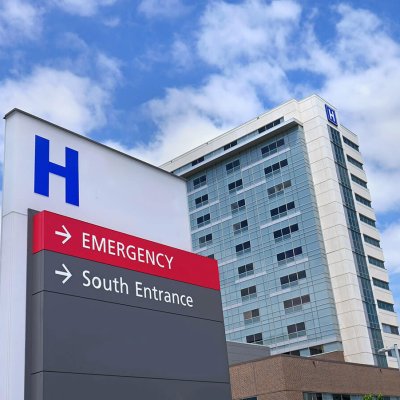Disclaimer: If you have reason to believe there is a medical emergency, immediately call 911.
When illness or injury suddenly occurs or intense symptoms occur, it can be stressful to choose between waiting to see your primary healthcare provider or seeking out immediate care. Even then, immediate medical services present a choice: urgent care vs. ER visit.
It’s common for people to worry they are overreacting or to dread a large ER bill. Many wonder if they could’ve waited or gone to a local urgent care. While the decision itself can be stressful, it’s important to remember that it’s better to know that nothing is seriously wrong than to wait to seek care when it is an emergency.
To help people know which medical facility is most appropriate, we’ve outlined some common situations and symptoms that can help you make a more informed decision.
What is Urgent Care?
Urgent Care centers are a type of medical facility designed to assist patients with an illness or injury that doesn’t appear to be life-threatening, but also can’t wait for the next available appointment at their primary doctor’s office. These centers typically have shorter wait times than emergency rooms and patients are generally seen in order of arrival.
Urgent care facilities can be specialized, but the healthcare professionals on staff are experienced in evaluating and caring for a wide scope of injuries or illnesses. In a way, it’s the marriage between family practice and emergency medicine as urgent care doctors and physician assistants see patients of all ages and genders.
What is Emergency Care?
The emergency room, or ER, is the emergency department of a hospital where immediate medical attention is given, usually in order of most immediate to least, and where ambulances go after responding to a situation. The ER is designed for emergencies only and can become clogged when people go for non-emergency medical situations, creating long waits.. While the ER can be convenient because it’s always open, it offers immediate attention only for those who require immediate medical care, such as in life-threatening situations.
When to Go to Urgent Care or the Emergency Room
When choosing between urgent care vs. emergency room, it’s helpful to learn which symptoms and conditions may require treatments only available in a hospital or may indicate a life-threatening situation:
ER Care
- Chest Pain or Pressure: Potential signs of a heart attack, especially if accompanied by shortness of breath, sweating, or pain radiating to the arm, jaw, or back.
- Severe Abdominal Pain: Especially if it’s sudden and intense and accompanied by fever, vomiting, or swelling.
- Difficulty Breathing or Shortness of Breath: Could be signs of severe asthma, allergic reaction (anaphylaxis), or other respiratory issues.
- Severe Headache: Especially if it’s the worst headache ever experienced by the person or accompanied by vision changes, confusion, or difficulty speaking. It could be indicative of a stroke or aneurysm.
- Sudden Vision Changes: Loss of vision, double vision, or severe eye pain could be a sign of a stroke or other serious conditions.
- Weakness or Numbness: Especially on one side of the body as a sudden onset could indicate a stroke.
- Severe Trauma or Injury: Head injuries, deep cuts, broken bones, severe burns, or any injury from a car accident or fall.
- Uncontrollable Bleeding: Wounds that don’t stop bleeding with pressure.
Severe or Persistent - Vomiting or Diarrhea: Especially if accompanied by dehydration signs such as dizziness, lack of urination, or lethargy.
- High Fever: Infants (especially under three months) with a fever and adults with a fever over 103°F (39.4°C) or a high fever that doesn’t respond to medication.
- Severe Allergic Reactions: Swelling of the face, lips, or throat, and difficulty breathing, hives, or anaphylaxis.
- Pregnancy-Related Issues: Severe pain, heavy bleeding, or other concerning symptoms.
- Seizures: Especially if it’s the first seizure, it lasts more than five minutes, or the person has difficulty breathing afterward.
- Poisoning or Overdose: Ingesting of a toxic substance or drug overdose.
- Loss of Consciousness or Fainting: Especially if it’s sudden and unexplained.
Urgent Care
- Minor Cuts and Lacerations: Cuts that may require stitches but are not bleeding uncontrollably.
- Mild to Moderate Abdominal Pain: Pain that is not severe or alongside other serious symptoms, like a high fever or persistent vomiting.
- Cold and Flu Symptoms: Cough, sore throat, runny nose, fever, and body aches.
- Minor Infections: Urinary tract infections, ear infections, sinus infections, or pink eye.
- Mild to Moderate Asthma Symptoms: Breathing difficulties that are not severe or life-threatening.
- Skin Rashes and Infections: Rashes, minor burns, or insect bites/stings that are not causing severe symptoms.
- Allergic Reactions: Mild to moderate reactions, those that do not involve severe swelling, difficulty breathing, or anaphylaxis.
- Minor Burns: First-degree burns or small second-degree burns that are not extensive or deep.
- Mild to Moderate Dehydration: Symptoms such as dry mouth, dizziness, or lightheadedness that do not involve confusion or fainting.
- Fever: Moderate fever without other serious symptoms, especially in adults and older children.
- Vomiting or Diarrhea: Without severe abdominal pain, high fever, or signs of severe dehydration.
- Mild to Moderate Headaches: Tension headaches or migraines that are not the worst headache ever experienced and are not accompanied by neurological symptoms.
- Back Pain: Acute back pain that is not associated with trauma or neurological symptoms like numbness or weakness.
- Minor Eye Injuries: Foreign objects in the eye, minor eye pain, or redness that don’t significantly affect eyesight.
- Ear Pain: Earaches or discomfort without severe symptoms like high fever or drainage of pus.
- Minor Respiratory Issues: Mild shortness of breath, mild asthma attacks, or bronchitis symptoms.
- Minor Allergic Reactions: Reactions like localized hives without severe swelling or respiratory symptoms.
- Animal or Insect Bites: Bites that are not severe or bleeding excessively, and do not involve symptoms of infection or allergic reaction.
Orthopedic Urgent Care
- Acute Joint or Muscle Pain: Sudden and severe pain in joints or muscles that could indicate a sprain, strain, or minor injury.
- Suspected Fractures or Broken Bones: A minor fracture or broken bone, particularly in the arms, legs, hands, or feet, that does not involve severe deformity or bone protruding through the skin(compound fracture).
- Sprains and Strains: Injuries to ligaments (sprains) or muscles and tendons (strains) from activities or accidents.
- Sports Injuries: Injuries sustained during sports activities; tennis elbow, runner’s knee, or minor dislocations, for example.
- Back Pain: Acute back pain that isn’t accompanied by neurological symptoms, such as loss of bladder control or severe weakness.
- Minor Dislocations: Dislocations that do not involve severe deformity or open wounds.
- Overuse Injuries: Conditions like tendinitis, bursitis, or stress fractures from repetitive motions.
- Swollen Joints: Sudden swelling in joints due to injury or other non-emergency conditions.
Proliance Urgent Care
- Unless a condition is life-threatening, a trip to urgent care is generally a better use of a patient’s time and resources to treat most orthopedic injuries.
- Urgent care centers often have far shorter wait times than the ER and cost less than a traditional hospital emergency room visit.
- Our urgent care facilities have surgeons and PAs who see scheduled patients so follow-up is streamlined and you can often see the same provider if requested.
At Proliance Surgeons, we understand the need for urgent care, especially orthopedic care that may require surgical treatments. Explore our urgent care facilities and see which are closest to you so that you are ready when one is needed.
Proliance Orthopedic Urgent Care – Covington
27005 168th Place SE Suite 201
Covington, WA 98042-4902
coordinates
Proliance Orthopedic Urgent Care – Kirkland
12911 120th Avenue NE Suite H-210
Kirkland, WA 98034-3061
coordinates
Proliance Orthopedic Urgent Care – Tacoma
1724 W. Union Suite 100
Tacoma, WA 98405-2099
coordinates
Proliance Orthopedic Urgent Care – Issaquah
510 8th Ave NE Suite 200
Issaquah, WA 98029-5436
coordinates
Proliance Orthopedic Urgent Care – Bellingham
2979 Squalicum Pkwy Suite 203
Bellingham, WA 98225
coordinates
Proliance Orthopedic Urgent Care – Tukwila
150 Andover Park W.
Tukwila, WA 98188






